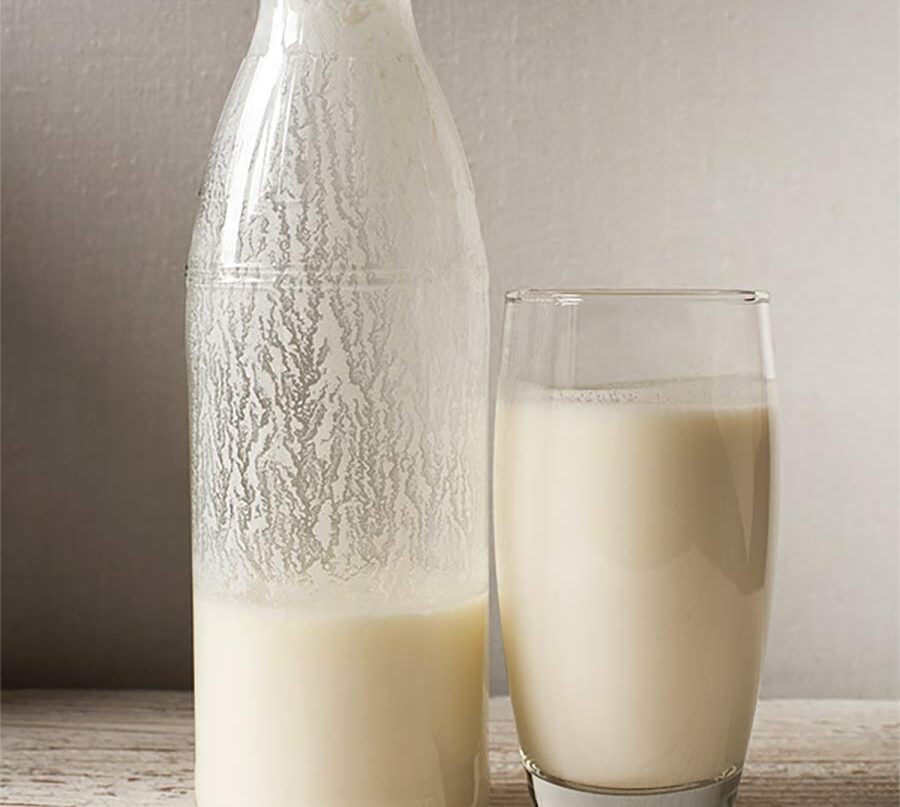Is dairy healthy?
Feb 2020
I have learned over the past few years that there is a big difference between the information I can share one-to-one with my nutritional therapy clients and that which I can share with a broader audience through my writing.
When I write, I don’t know anything about the people who are reading my words. Over time, I have therefore become increasingly conscious of trying to make this information as broadly applicable, safe and balanced as possible. It cannot say exactly what you should or should not do, as every ‘you’ is different.
When, however, I am working with a client, I do know about them; their history, nutritional requirements, likes, dislikes and lifestyle. I can therefore make much more specific recommendations and can also follow up over time to see if my suggestions are working.
The question of whether or not to consume dairy is a great example of this difference and one that really has no ‘right’ or ‘wrong’ answer.
Personally, for example, I am lactose intolerant and really struggle to consume much dairy at all. But Willow, my daughter, is fine with dairy, so she enjoys it regularly.
If you suffer from a dairy allergy or intolerance (as many of my clients seem to), are choosing to eat more plant-based, or simply feel better without it, for example, then I would suggest it is OK to continue avoiding dairy. Do make sure, however, that you are getting the equivalent nutrients from other sources.
However, if you love the taste of dairy products, and feel fine with them in your diet, then it is also OK to continue enjoying them regularly. Dairy products are still recommended by most nutritional guidelines around the world, and where possible, it’s a good idea to keep our diets as varied as we can (Lamarche et al., 2016).
Either way, learning to listen to your body and notice how different foods make you feel (if they make you feel anything) is often a good place to start. But so is being informed about the choices you are making.
I hope this article and some of the further reading it recommends may help a bit with the latter.
Please note: This article refers specifically to dairy consumption in adults. The guidelines for babies and children are significantly different and are not covered here.
What are some of the differences between dairy milks?
Full-fat vs. Low-fat
The total fat content of dairy products varies a lot. While opinions about the potential risks of saturated fat have changed over the past few years, it is still generally considered better to have less saturated and trans fats and more unsaturated fats (such as those found in olive oil, oily fish, nuts & seeds etc.).
Unless you are drinking a lot of milk, the overall difference in grams of saturated fat consumed between a skimmed (0.1-0.3% fat), semi-skimmed milk (around 1.7% fat) and whole milk (around 3.25% fat) is often not that significant, especially when compared to what you’d get from a single portion of cheese (which can be up to 40% fat) or butter, for example. So a moderate intake of milk is not something I’d worry about regarding saturated fat content. I do recommend sensible moderation when it comes to butter, cheese and cream, however.
A review of randomised studies of high vs. low fat dairy concluded that for most healthy people, it would be reasonable to include both low and whole fat dairy food as part of a healthy diet (Benatar, Sidhu and Stewart, 2013).
When dairy products, particularly yoghurts, have been processed to make them lower fat, it’s sensible to be aware of what that fat has been replaced with. Often it is sugar, sweeteners or other additives. Instead of these, I’d suggest unsweetened natural yoghurt and adding fresh or frozen fruit to it.
Organic
Organic milk may contain slightly more omega-3 fat (although less of the essential minerals iodine and selenium) than non-organic milk (Średnicka-Tober et al., 2016). The absolute difference in omega-3 fats is not huge though and could be made up for by eating some oily fish, for example.
We don’t yet know what long-term effects – if any – potential residual chemicals (such as antibiotics, pesticides etc.) and hormones found in milk may have on us.
In the UK, there are different animal welfare regulations between organic and non-organic milk production.
Raw milk
Pasteurisation of milk helps to ensure it is safe to drink by reducing the number of potentially harmful microbes (such as E.Coli bacteria) contained within it. It can also prolong shelf life and minimise food waste by reducing numbers of spoiling bacteria.
Some people, however, advocate for raw milk, as they feel that pasteurisation reduces the potential nutritional benefits. There is not enough high-quality research yet to say definitively what these benefits, or risks might be (MacDonald et al., 2011).
It is advised that pregnant women, infants, small children, elderly people and those with a compromised immune system do not consume raw milk, or products (such as yoghurt / cheese) made from it, due to the potential risk of infection.
For more information on the safety of raw milk: food.gov.uk/safety-hygiene/raw-drinking-milk
A1 vs. A2
A major source of the protein found in milk is called beta-casein, of which there are two subtypes – named A1 and A2. It is now possible to buy milk that has only the less common A2 protein (most supermarket milk also has A1).
Some studies have found that, in people with milk intolerance, A2 milk may give them fewer gastrointestinal symptoms (such as bloating or pain), compared to regular milk. This suggests that there may be some people who, instead of being intolerant to the lactose sugar, are intolerant to the A1 milk protein casein instead (Jiaqin et al., 2016, Pal et al., 2015, Allison and Clarke, 2005).
These studies have been small and many have been funded by the A2 industry, so as ever, larger independent studies are needed (Truswell, 2005).
What are some of the potential issues with dairy?
Many people in the UK are reducing their intake of milk, or avoiding it altogether, due to concerns over animal welfare and sustainability. While these are, of course, valid reasons to shift our dietary patterns, this article will look at the more nutritional aspects of milk instead.
Lactose intolerance
Intolerance to milk-containing foods is common and increases with age. This is thought to be because as we get older, our need to digest milk declines (which we would originally have only consumed from our mother’s breast).
The majority of the world’s population starts to decrease their ability to digest milk by the age of 3-5 years. This trend then continues as we get even older; in one study, around half of adults over 50 were lactose intolerant and around a quarter were under the age of 50, although this does vary between ethnic groups and Northern Europeans seem to have one of the highest lactose tolerances (Rao et al., 1994, Montgomery, Grand and Buller, 2015).
Milk intolerance is caused by low levels of the enzyme ‘lactase’ which breaks down the milk sugar known as ‘lactose’. This is usually due to a genetic trait, which means that we don’t produce enough of the lactase enzyme anymore (Montgomery, Grand and Buller, 2015).
This matters because lactose sugar needs to be broken down into two smaller sugars, glucose and galactose, before it can be absorbed as energy.
If this breakdown doesn’t happen, then the lactose travels onwards from the small bowel into the large bowel. In those who don’t have good lactase enzyme activity, around 75% of the unabsorbed lactose sugar will pass into the large bowel (Montgomery, Grand and Buller, 2015).
When unabsorbed lactose reaches the colon it is fermented by the gut bacteria, producing gas. This can distend and stretch the bowel walls, leading to discomfort and bloating, two of the classical signs of lactose intolerance. The higher sugar load of the large bowel also draws water into the gut, which can sometimes lead to loose stools or diarrhoea (Montgomery, Grand and Buller, 2015).
The symptoms of lactose intolerance may include the following (noticed after eating at least two servings of dairy / day)*
- Long-term problems with diarrhoea
- Abdominal pain or discomfort
- Bloating
- Flatulence
*Note: These symptoms are very non-specific, so if you are suffering from any of the above, or are worried you might have lactose intolerance, do see your GP to just check there is nothing else that might be going on. This is especially important in children.
Lactose intolerance & yoghurt / cheese
Processing milk into yoghurt or cheese may reduce the amount of lactose sugar it contains. For example, when making yoghurt, some of the lactose is fermented to produce lactic acid, which gives yoghurt its characteristic tangy taste.
Therefore, some people who can’t tolerate milk particularly well due to lactose intolerance may find that they are able to eat small portions of yoghurt or cheese. This will always vary from person-to-person.
Inflammation
The degree to which dairy products can result in inflammation is variable depending on lots of individual factors, perhaps the most important being in those people who have an allergy to milk.
If we eat foods that our immune system reacts to (called a ‘hypersensitivity’ reaction), this can lead to a pro-inflammatory state (Bordoni et al., 2015). It is sensible in those instances to avoid consuming dairy products. If in doubt, ask for professional advice on this.
However, according to the findings of a review on the topic, dairy – particularly fermented dairy products (like yoghurt & cheese) – could also have some anti-inflammatory effects. This may be, in part, due to the bacteria they contain, perhaps interacting with our own gut microbiota (which we know plays a key role in modulating and communicating with the immune system) (Bordoni et al., 2015).
Fractures
The idea that high milk consumption directly reduces the risk of broken bones, particularly as we age, has been questioned in recent years.
A British Medical Journal study reported that high milk consumption does not necessarily protect against fractures and for women in particular, might even increase risk (Byberg et al., 2014). Further studies have had more neutral effects, however, while others have suggested a slight reduction in the risk of having a hip fracture in women who drank more milk (Lamarche et al., 2016).
Again, more research is needed (especially amongst different ethnic groups, who may have higher or lower rates of lactose intolerance).
In the meantime, however, the Royal Osteoporosis Society has some useful articles on Looking After Your Bones (and specifically on Nutrition for Bones). theros.org.uk/.
If you’re interested in the links between dairy and bone health in children, take a look at this NHS article on ways to ‘boost your child’s bone health’ if you’d like more information: https://www.nhs.uk/live-well/healthy-body/bone-health-in-children/
Acne?
I personally found that my acne vastly improved without dairy.
I have often queried if this happened due specifically to the reduction in dairy, or because I replaced that dairy with lots more fresh fruits and vegetables, or perhaps a combination of the two. But I was interested to read this article recently, which gives an interesting take on a potential mechanism underlying the link between dairy and acne: examine.com/
As always, it is each to their own and it’s important to be in tune with our own bodies. The link between diet and acne is still a contentious one.
It’s worth mentioning, however, that I am careful to ensure I am replacing the nutrients of any foods I remove (from whole food sources where possible), as well as looking more broadly at my lifestyle. Stress and poor sleep, for example, are other big acne triggers for me.

The bottom line?
Dairy products can be enjoyed by many of us as part of a balanced diet (particularly by those of Northern European descent, where there tends to be less incidence of lactose intolerance in adulthood). They contain a wide range of essential nutrients and can bring diversity and taste benefits to our diet.
However, for some people, reducing or removing dairy products from the diet may be beneficial for a variety of reasons as touched on above. If you think that you might be dairy intolerant, or have other concerns related to subjects discussed in this article, please consult with your healthcare provider, as the symptoms are rather non-specific and it is important to ensure that you are not missing another diagnosis.
If you do choose to reduce the amount of dairy you are consuming, it is important to make sure that you have plenty of other sources of the essential nutrients that it provides – particularly calcium, iodine and B-vitamins. Take a look at my article on 9 nutrients in a plant-based diet for further information on alternative sources.
There are now plenty of great tasting dairy alternatives available. However, these have variable levels of nutrients (and tend to be lower in protein), so always read the labels. Look out for options that contain added calcium and iodine and try to minimise sweeteners, sugars, emulsifiers or other artificial additives. It is more important to consider what we do eat in our diets, than what we don’t eat.
MORE TO EXPLORE
Please note that the information on this website is provided for general information only, it should not be treated as a substitute for the medical advice of your own doctor or any other health care professional providing personalised nutrition or lifestyle advice. If you have any concerns about your general health, you should contact your local health care provider.
This website uses some carefully selected affiliate links. If you buy through these links, we may earn an affiliate commission, at no additional cost to you. This helps to keep all of our online content free for everyone to access. Thank you.




